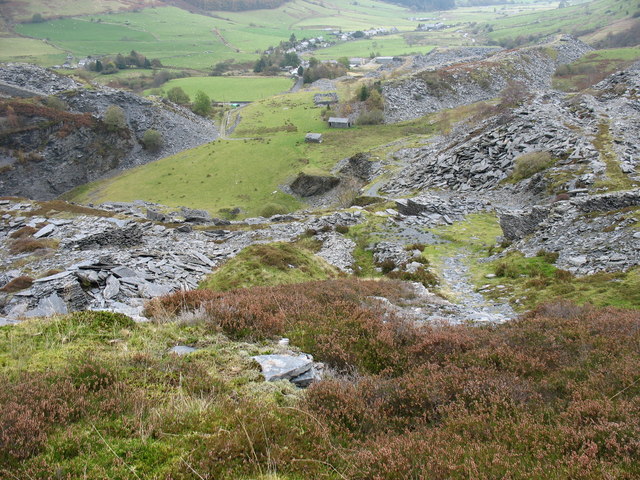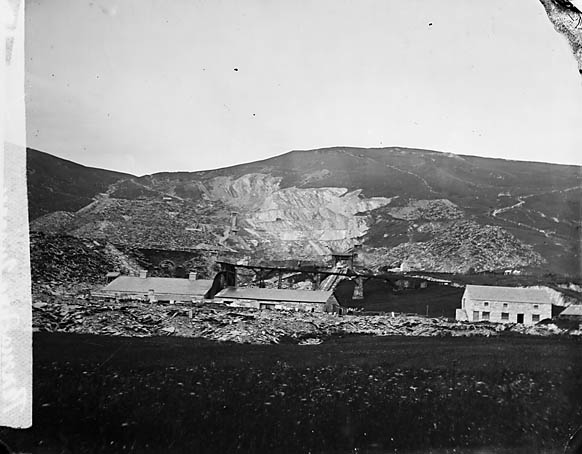Penmachno Quarry on:
[Wikipedia]
[Google]
[Amazon]

 The Penmachno quarry (also known as Cwm Machno quarry, Rhiwfachno quarry, or Tan-y-Rhiw quarry) was a
The Penmachno quarry (also known as Cwm Machno quarry, Rhiwfachno quarry, or Tan-y-Rhiw quarry) was a

 The Penmachno quarry (also known as Cwm Machno quarry, Rhiwfachno quarry, or Tan-y-Rhiw quarry) was a
The Penmachno quarry (also known as Cwm Machno quarry, Rhiwfachno quarry, or Tan-y-Rhiw quarry) was a slate
Slate is a fine-grained, foliated, homogeneous, metamorphic rock derived from an original shale-type sedimentary rock composed of clay or volcanic ash through low-grade, regional metamorphism. It is the finest-grained foliated metamorphic ro ...
quarry
A quarry is a type of open-pit mining, open-pit mine in which dimension stone, rock (geology), rock, construction aggregate, riprap, sand, gravel, or slate is excavated from the ground. The operation of quarries is regulated in some juri ...
near Cwm Penmachno
Cwm Penmachno (historically called Tre-Gynwal) is a village at the head of River Machno, Cwm Machno in North Wales.
History
The village was built in the 1860s as a quarry settlement. The Penmachno quarry lay immediately south and above the se ...
, Conwy
Conwy (, ), previously known in English as Conway, is a walled market town, community and the administrative centre of Conwy County Borough in North Wales. The walled town and castle stand on the west bank of the River Conwy, facing Deganwy ...
, North Wales
North Wales ( ) is a Regions of Wales, region of Wales, encompassing its northernmost areas. It borders mid Wales to the south, England to the east, and the Irish Sea to the north and west. The area is highly mountainous and rural, with Snowdon ...
. It was directly below the Rhiwbach Quarry. It was worked between 1818 and 1962.
History
The quarry was originally known as the Tan-y-rhiw quarry, and it was recorded working in 1818. By 1872, the quarry was employing 72 workers, rising to 178 in 1898 at its peak. In 1909, the quarry stopped working for two weeks due to a general depression in the price of slates. In 1937, Penmachno employed 108 quarrymen. It continued working after theSecond World War
World War II or the Second World War (1 September 1939 – 2 September 1945) was a World war, global conflict between two coalitions: the Allies of World War II, Allies and the Axis powers. World War II by country, Nearly all of the wo ...
, eventually closing in 1962.
Transport
Unlike most Welsh slate quarries, it had no railway connection to the outside world, and most of the slate it produced was taken by horse-and-cart to a wharf on theRiver Conwy
The River Conwy (; ) is a river in north Wales. From its source to its discharge in Conwy Bay it is long and drains an area of 678 square km. "Conwy" was formerly anglicised as "Conway."
The name 'Conwy' derives from the old Welsh words ''c ...
at Trefriw. In 1868, the LNWR opened their line to Betws-y-Coed and from that date onwards slate could be hauled there, which was still a distance of nearly over rough mountain roads.
In the first decade of the 20th century a traction engine was purchased to haul the carts. This arrangement was later replaced by lorries. Some slate was hauled up to Rhiwbach Quarry and taken out to Blaenau Ffestiniog over the Rhiwbach Tramway. There were proposals to link Penmachno and Rhiwbach quarries by tramway, but these proposals were never implemented.
Internally, the quarry had a number of gauge tramways and inclines. During the later years of operation a Motor Rail Simplex locomotive was purchased to work the lower tramway. Several proposals were made to connect the quarries by rail.
Geography
The quarry was near the head of the isolated valley of theRiver Machno
River Machno () is a river in Snowdonia in north-west Wales, United Kingdom. It is the first major tributary of the River Conwy, which it joins south of Betws-y-coed, past the Pandy Falls and the Machno Falls.
The river originates in the hills ...
, above Penmachno village. Its height on the mountain meant it had a relatively restricted water supply, and on several occasions work stopped due to drought, including in 1891. It was worked as a series of galleried pits, as well as underground chambers.
The highest point of the quarry was just above above sea level. The mills level, at the lower end, was at elevation. There were originally two pits, the upper working was known as Rhiw Fachno and the lower one was the main Cwm Machno quarry. Adits lead into the mountain from both pits to access the underground workings. About above the Rhiw Fachno pit was the quarry reservoir.
Geology
The five main veins ofOrdovician
The Ordovician ( ) is a geologic period and System (geology), system, the second of six periods of the Paleozoic Era (geology), Era, and the second of twelve periods of the Phanerozoic Eon (geology), Eon. The Ordovician spans 41.6 million years f ...
slate that pass through Blaenau Ffestiniog are the North, Back, Narrow, Main (or Old) and South (or New) veins. As they head eastwards, the lower three thin out and disappear, so that by the time Cwt y Bugail Quarry is reached, only the North Vein and Back Vein are left. Immediately to the east of the Cwt y Bugail main adit, the strata are cut by the Dolwyddelan fault, and the same two veins re-appear at Rhiwbach and Penmachno, some further to the south east, and at a considerably lower altitude.
Bardic chair
The chair for the 2019National Eisteddfod of Wales
The National Eisteddfod of Wales ( Welsh: ') is the largest of several eisteddfodau that are held annually, mostly in Wales. Its eight days of competitions and performances are considered the largest music and poetry festival in Europe. Competito ...
, held near Llanrwst, was made from slate from Penmachno quarry.
References
{{Welsh Slate Quarries Slate mines in Conwy County Borough Bro Machno Railway inclines in Wales Industrial railways in Wales 2 ft gauge railways in Wales